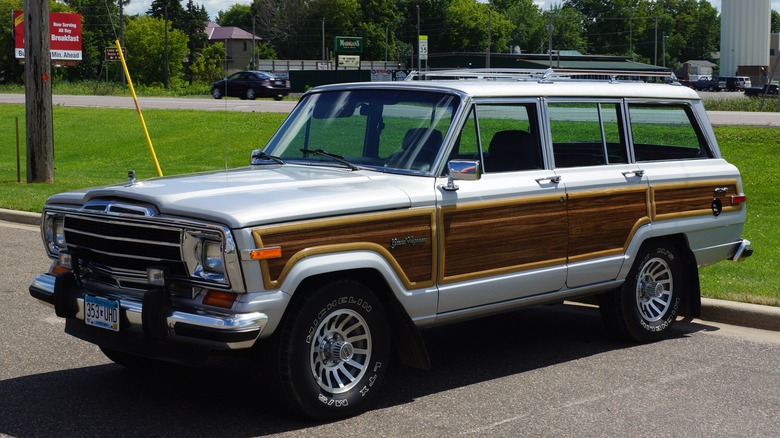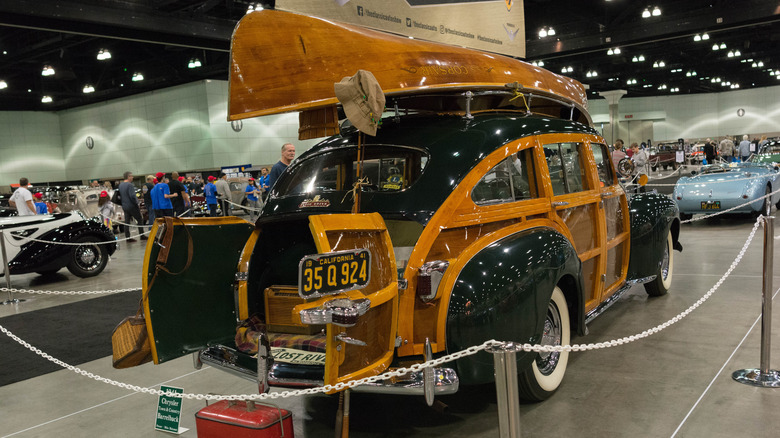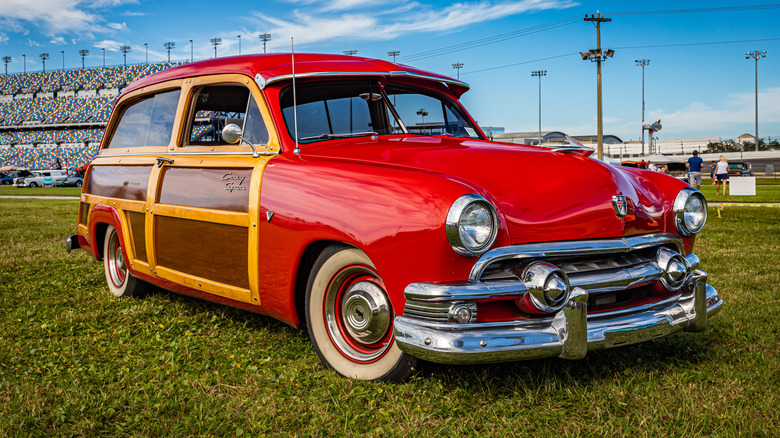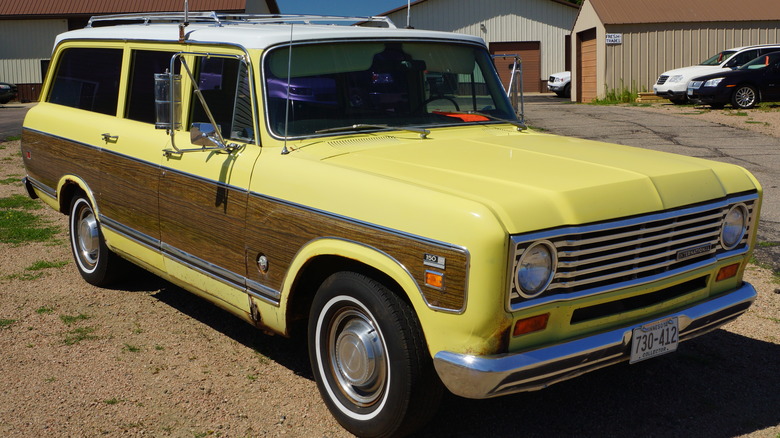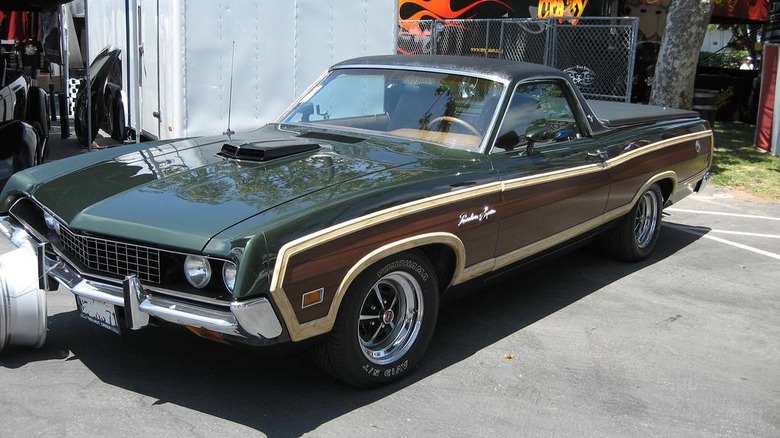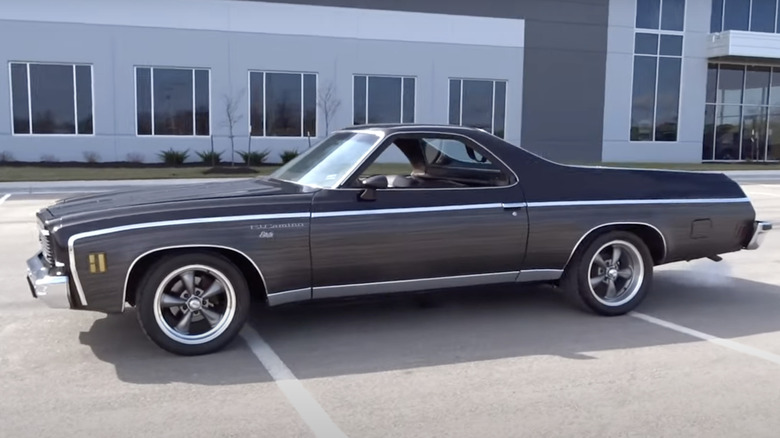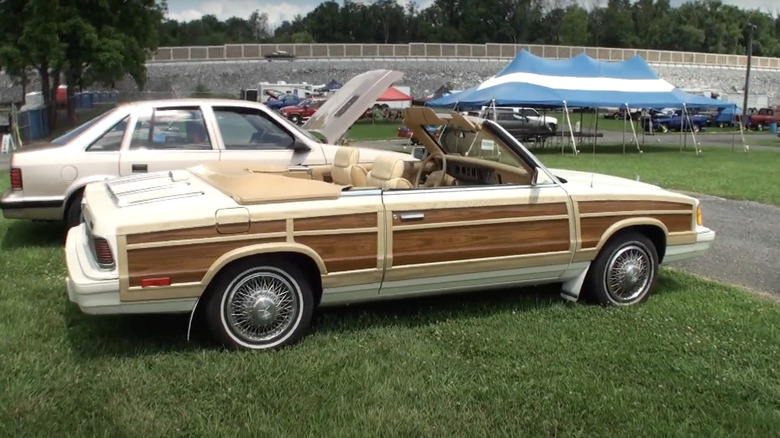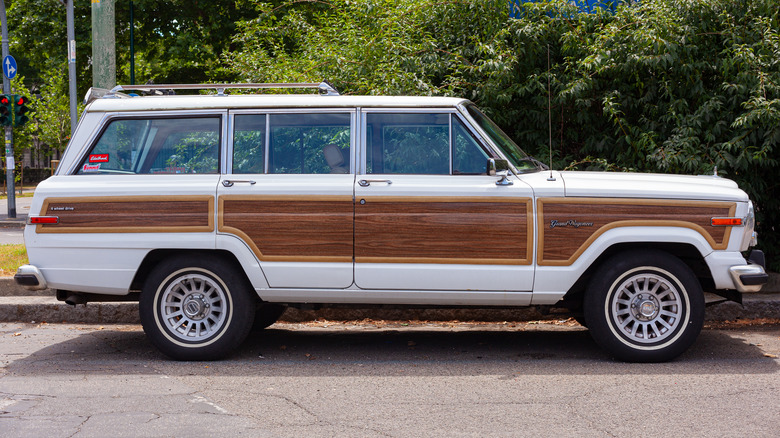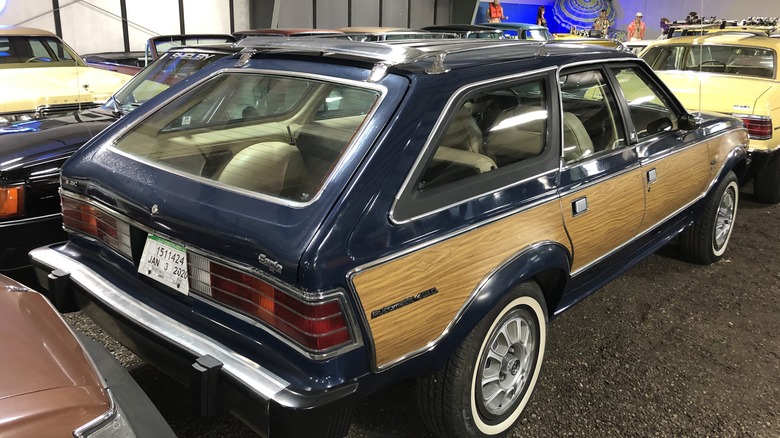8 Of Our Favorite Wood-Paneled Vehicles Of All Time
In the nearly century and a half since Carl Benz invented the first-ever car with his Patent Motorwagen, automotive design has seen some remarkable trends. The 1949 Ford's airplane-inspired body influenced carmakers for decades afterward, and tailfins were dominant in classic cars from the '50s and '60s. Soon after those mighty rear-end wingtips began to disappear, the U.S. obsession with wood-grain paneling made its way from basement rec rooms to vehicles on the streets.
Cars, trucks, and SUVs from the 1970s and '80s weren't the first to get the wood-grain treatment, but the feature proliferated during that period like shag carpeting and bright pastel kitchen appliances. Those of us who came of age during that era still retain a particular fondness for this design feature, even though most wood-grain paneling from this time was nothing more than vinyl adhesive applied to mimic the real wood siding used on vehicles from bygone days. Nevertheless, here are eight of our favorite wood-paneled vehicles of all time.
[Featured image by Greg Gjerdingen via Wikimedia Commons | Cropped and scaled | CC-BY 2.0]
The Chrysler Town & Country debuted in 1941
Before machine production made it easy for automakers to shape steel to their liking, many of them used wood to build vehicle bodies. The material was plentiful and light, and could be changed out easily if damaged. Even after the transition to steel bodies was well underway in the 1920s and '30s, some automakers wanted to keep the classic wood-paneled look that was becoming a relic of the stagecoach era. In 1939, Chrysler commissioned the Boyertown Bodyworks in Boyertown, Pennsylvania to build some bespoke station wagon bodies. The resulting design was named the "Town & Country" because — according to Classic Driver – "the front of the car looked 'town,' and the rear 'country.'"
The model went into production in 1941 and was marketed to wealthier customers who prioritized appearance over durability or economy. The hood, roof, fenders, and running boards were metal, but the doors and much of the interior were mahogany and ash. The six-passenger version sold for $1,412 (about $31,000 today), and it was also offered in a nine-passenger version with a rear bench seat. That feature cost an additional $80, which equates to a little under $1,800 in 2024 dollars. The wood-paneled T&C returned from 1946 through 1950 in sedan and convertible form, and Chrysler later used the badge on station wagon and minivan models that featured vinyl faux wood-grain stuck to their sides.
The stately Ford Country Squire had a long run
As we mentioned earlier, the 1949 Ford lineup featured Jet-Age styling. But along with heaping helpings of chrome, Ford also adorned those cars with wood paneling on the doors. In early 1950, the Country Squire label first appeared, and the first generation of that model ran through 1951. The panels were part of the body structure and made of mahogany-veneered plywood with birch framing. The interior also had generous helpings of mahogany, although the steering wheel was classic 1950s Bakelite. Real wood was only used in 1950 and 1951, and when the second generation debuted in 1952, Ford switched to all-steel bodies with simulated woodgrain.
The Country Squire nameplate carried on through 1991, making it Ford's third longest-running model in North America, behind the Thunderbird and Mustang. If you're looking for one of these classic beauties, we found four current listings for 1949-1951 Ford wagons with real wood paneling at Classic.com for between $36,000 and $160,000.
The IH Travelall was overshadowed by the Scout
International Harvester made rifles, refrigerators, and farm equipment from tractors to milking machines, but is probably most famous for producing the Scout SUV, a model that lived in various forms from 1960 through 1980. In 1953, International introduced the Travelall, a bigger model that got four-wheel drive in 1956 and had large vinyl wood-grain decals along almost its entire length. The Travelall had a commercial pedigree; it was based on International's R series of panel trucks. It was relatively popular and remained in production through 1975, but few examples have survived until now despite their sturdy construction.
Chicago classic car dealer Charles Kuhn told The New York Times that this was likely because of the Travelall's common use as a work and adventuring vehicle. "Most probably lived long, hard lives in the hands of tradesmen and outdoors types and were just used up well before there was any thought about collectibility," he noted.
The optional faux wood grain didn't appear on the Travelall until the fourth and final generation, which ran from 1969 through 1975. These models are scarce today; Classic.com shows only two listings for fourth-gen Travelalls and 20 completed sales in the past five years. Those transactions ranged from $6,500 for a white 1969 diesel-powered model without the fake wood grain to $110,000 for a fully restored white 1970 Custom version with the applique intact.
[Featured image by Greg Gjerdingen via Wikimedia Commons | Cropped and scaled | CC-BY 2.0]
The Ford Ranchero Squire spanned the entire '70s
Ford introduced the Ranchero in 1957 as a "ute" similar to the ones popular in Australia. It had a coupe body and pickup bed, and the model stayed in production over seven generations through the 1979 model year. Ford sold just over half a million Rancheros over that span, including almost 46,000 in 1973 alone. The imitation wood-grain sides were reserved for the Squire variant of the Ranchero, which debuted for the 1970 model year as a luxury version of the ute. Along with the simulated wood panels, the Ranchero Squire had upgraded upholstery, carpeting, and wheel covers. The Squire was a hit in its first year, accounting for almost one in five Rancheros produced.
The model pictured above is from that debut year, and the Squire lasted through the end of the Ranchero's run in 1979. They're not particularly common these days, although we found a pristine 1971 example that sold in January for $40,000 and a slightly weather-faded 1970 specimen that went in 2020 for just over $23,000. Although the submodel was officially known as the Ranchero Squire, they are sometimes listed as "Ranchero Country Squires," so keep that in mind when searching.
[Featured image by Brian Toad Photography via Wikimedia Commons | Cropped and scaled | CC BY-SA 3.0]
The El Camino Estate was Chevy's answer to the Ranchero Squire
Chevrolet released the El Camino in 1959 in response to the Ranchero and gave it the fake wood treatment in the early 1970s as well. The "wood"-paneled version of the El Camino was known as the Estate. Introduced in 1973 as an option package on El Camino Standard and Custom models, the Estate moved over to the Classic variant before replacing the Custom in 1974. Along with the vinyl wood-grain siding, the Estate package included metal molding along the sides of the body and over the wheel arches.
The Estate was only offered through 1976 and didn't carry over into the fifth-generation El Camino the following year. El Camino Estates with wood-grain sides are very hard to find 50 years after you could drive one off the lot. We scoured the web and couldn't find a single active listing for one with this feature, and one Estate we found that had sold recently either never had the vinyl wood-grain paneling or has since had it removed.
Chrysler's LeBaron T&C Convertible had a short run
Chrysler didn't keep the Town & Country name (or its wooden sides) reserved for the station wagon and minivans that wore the badge. From 1983 through 1986, the automaker made a LeBaron Town & Country convertible with (not real) wood-grain panels running nearly the car's entire length. Chrysler wasn't content to just slap some stickers on the LeBaron, though. Designers added wide plastic trim pieces made to mimic the ash accents of the '40s Town & Country models. Chrysler only made 1,105 Town and Country convertibles in its four-year run, and only 501 of those were 1986 models like the one above.
Owner Byron Olenski told Lou Costabile on his My Car Story YouTube channel that he is often complimented on the car's wood-grain finish. "I get thumbs-up all the time," Olenski said. "People usually comment on the way the wood looks." Considering the low original production numbers, Town & Country convertibles come on the secondhand market with surprising frequency. And because the LeBaron is not a particularly in-demand model, they tend to be relatively affordable. We found at least 10 T&C convertibles that have sold in recent years at Classic.com with prices ranging from $6,900 to $27,500.
Jeep went woody with the Wagoneer
Jeep got into the wood-grain game when it applied a thin strip of vinyl wood-grain applique to the Wagoneer around 1970. The model had been in production since 1963, and by the mid-'70s, the faux wood paneling had grown to nearly the height of the vehicle. That treatment continued with the introduction of the luxury-focused Wagoneer Limited in 1978; that submodel became the Grand Wagoneer in 1984. The classic styling and broad wood-grain paneling make the Wagoneer and Grand Wagoneer a favorite among Hollywood producers. Woodgrain-clad Wagoneers and Grand Wagoneers have appeared in hundreds of films like "Lassie," "Innerspace," and "The Freshman" as well as on an equal or greater number of television shows from "The Sopranos" to "Stranger Things."
A red 1991 Grand Wagoneer was also the chosen ride of Skyler White (Anna Gunn) on "Breaking Bad." After that show wrapped, the Jeep used in filming was offered up for auction and sold for $11,250. That's a pretty good price for a well-worn model, especially one with Hollywood fame. Hagerty values a 1991 Grand Wagoneer in good condition at $35,500, and we found one that sold last year for $86,900.
The AMC Eagle is an AWD classic
Long before seemingly every car available put power to the road via all four wheels, AMC adapted its Concord station wagon into the Eagle, a capable all-terrain cruiser with ample ground clearance and the same Quadra-Trac full-time four-wheel drive system found in 1970s Jeep CJ-7s, Cherokees, and Wagoneers. The Eagle debuted in late 1979 as a 1980 model, and demand was so strong that a six-month waiting list had built up by February. David A. Davis Jr. of Car and Driver gave the Eagle a thorough test drive and found it to be sure-footed and well-balanced. "It drives better than most [U.S.] sedans at any price," he wrote, "and it offers the manifold advantages of full-time four-wheel drive combined with independent suspension in a true family car."
The body-length wood-grain siding was framed by chrome trim, and the Eagle stayed in production through 1988. By then, AMC was Chrysler property, and the new ownership abandoned the entire AMC line to focus on the popular Jeep brand it acquired with its parent company. Chrysler later used the Eagle name for a separate brand of cars, but that unpopular line was discontinued after the 1998 model year.
Surviving AMC Eagles are fairly affordable today, if not necessarily easy to find. Classic.com shows just one listing but 34 sales over the last five years at an average price of $12,339.
[Featured image by Mr.choppers via Wikimedia Commons | Cropped and scaled | CC BY-SA 3.0]
